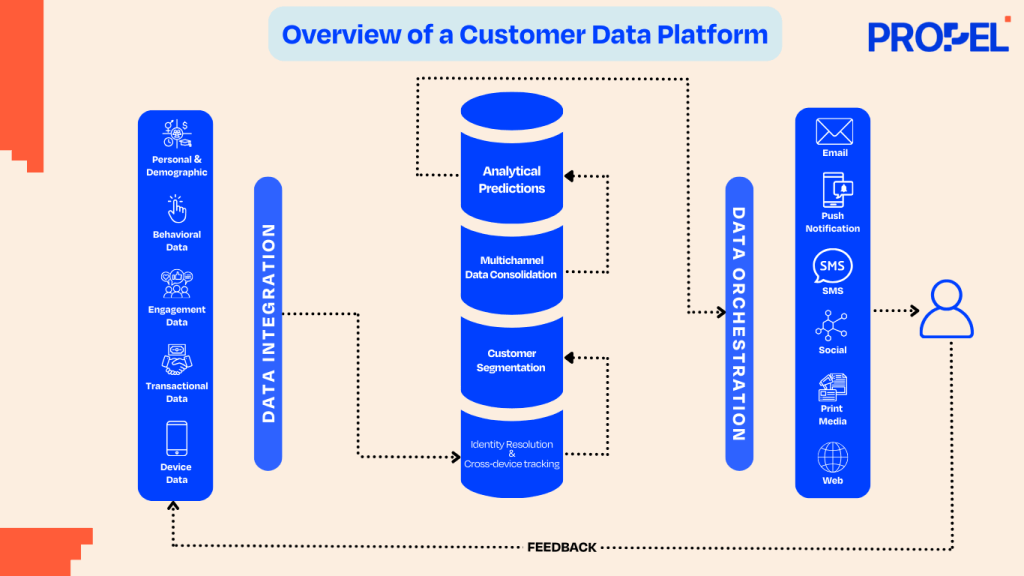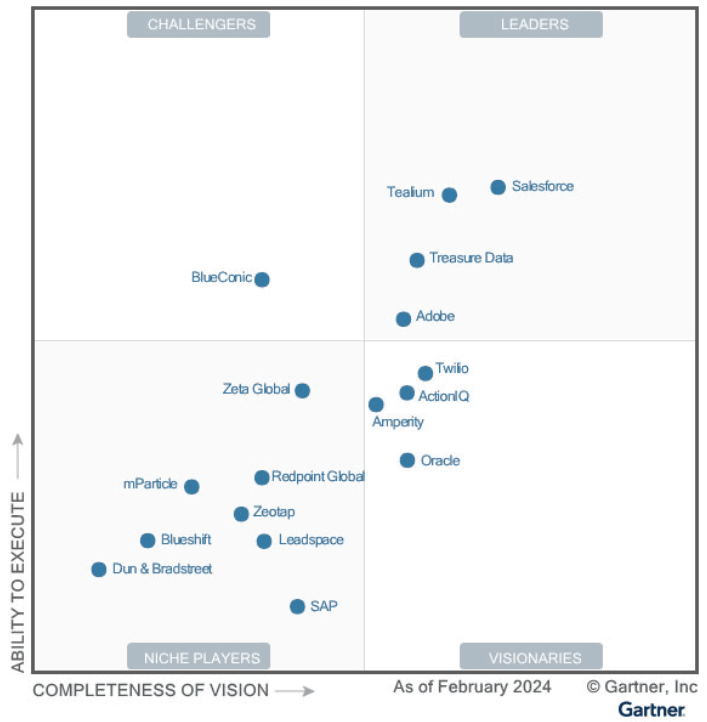In today’s data-driven business landscape, understanding and engaging customers on a personal level has become a critical success factor. However, with customer data spread across various touchpoints and systems, gaining a unified view of the customer journey remains a challenge for many organizations. This is where a Customer Data Platform (CDP) comes into play.
A CDP is a software solution that aggregates and unifies customer data from multiple sources, creating a single, comprehensive view of each individual customer. By bringing together data from various channels and systems, such as web analytics, CRM, email marketing, social media, and more, a CDP enables businesses to gain deep insights into customer behavior, preferences, and needs. This, in turn, empowers organizations to deliver personalized experiences, improve marketing effectiveness, and drive customer loyalty.

Description: Various Components of a Customer Data Platform (CDP)
The importance of CDPs in today’s market cannot be overstated. 78% of organizations either have or are planning to implement a CDP to enhance their customer data management capabilities. The CDP Market size is projected to grow from $7.4 billion in 2024 to $28.2 billion by 2028, at a compound annual growth rate (CAGR) of 39.9% during the forecast period. This growth is driven by the increasing need for businesses to deliver personalized customer experiences, optimize marketing efforts, and gain a competitive edge.
Implementing a CDP offers numerous benefits to organizations. By unifying customer data, CDPs provide a holistic view of each customer, enabling businesses to understand their preferences, behaviors, and needs.
This understanding allows for targeted marketing campaigns, personalized product recommendations, and seamless customer experiences across various channels. CDPs also enable real-time data processing, allowing businesses to respond quickly to customer actions and deliver timely and relevant communications.
Moreover, CDPs play a crucial role in customer retention and loyalty. It is known that 90% of companies that use CDPs have reported enhanced customer loyalty. By leveraging the insights gained from unified customer data, businesses can identify at-risk customers and proactively engage them with personalized retention strategies. CDPs also facilitate the creation of targeted loyalty programs, rewarding customers based on their individual preferences and behaviors.
In addition to the benefits mentioned above, CDPs also help organizations comply with data privacy regulations, such as GDPR and CCPA. With robust data governance and security features, CDPs ensure that customer data is collected, stored, and processed in a compliant manner, mitigating the risk of data breaches and maintaining customer trust.
When evaluating CDP solutions, there are several key features to consider to ensure that the platform meets your organization’s specific needs and goals.
1. Data Integration Capabilities
A CDP should have the ability to seamlessly integrate with various data sources, both internal and external, to create a unified customer profile. Look for a platform that supports a wide range of data sources, such as web and mobile analytics, CRM systems, email marketing platforms, social media, and more. The CDP should also have the capability to handle structured and unstructured data, ensuring that all relevant customer information is captured and consolidated.
2. Real-Time Data Processing
To deliver timely and relevant customer experiences, a CDP should be capable of processing data in real-time. Real-time data processing enables businesses to respond quickly to customer actions and behaviors, such as abandoning a cart or engaging with a specific piece of content. By leveraging real-time insights, organizations can trigger personalized communications and offers that drive engagement and conversion.
3. Customer Segmentation and Targeting
Advanced segmentation capabilities are a crucial component of a CDP. The platform should allow you to create dynamic customer segments based on various criteria, such as demographics, behavior, purchase history, and more. By leveraging these segments, businesses can deliver targeted marketing campaigns, personalized product recommendations, and tailored customer experiences that resonate with each individual.
4. Predictive Analytics and Machine Learning
To truly harness the power of customer data, a CDP should incorporate predictive analytics and machine learning capabilities. These advanced features enable businesses to anticipate customer needs, predict future behaviors, and optimize engagement strategies accordingly. By leveraging predictive models, organizations can proactively address customer churn, identify upsell and cross-sell opportunities, and deliver highly personalized experiences that drive long-term loyalty.
5. Data Privacy and Security
With the increasing focus on data privacy regulations, such as GDPR and CCPA, it’s essential to choose a CDP that prioritizes data security and compliance. Look for a platform that offers robust data governance features, such as data encryption, access controls, and audit trails. The CDP should also provide tools for managing customer consent and preferences, ensuring that your organization remains compliant with relevant regulations.
6. Scalability and Performance
As your business grows and customer data volumes increase, your CDP should be able to scale accordingly. Evaluate the platform’s ability to handle large data sets, high traffic volumes, and real-time processing requirements. Consider factors such as data ingestion speed, query performance, and the ability to handle peak loads without compromising system stability or user experience.
7. User-Friendly Interface and Customization
A CDP should have a user-friendly interface that allows marketers and business users to easily access and leverage customer data. Look for a platform with intuitive dashboards, drag-and-drop segmentation capabilities, and customizable reporting. The CDP should also provide flexibility in terms of customizing data fields, segment definitions, and integration with other marketing and analytics tools.
8. Customer Support and Resources
When selecting a CDP, consider the level of customer support and resources provided by the vendor. Look for a vendor that offers comprehensive documentation, training materials, and a dedicated support team to help you make the most of the platform. Additionally, consider the vendor’s roadmap and commitment to continuous innovation and updates to ensure that the CDP evolves with your business needs.
CDPs can achieve up to 360% increase in retention rates. A CDP plays a vital role in enhancing customer engagement and retention by enabling businesses to deliver personalized, timely, and relevant experiences across various touchpoints.
1. Personalization at Scale
With a unified customer view, CDPs allow businesses to deliver highly personalized experiences at scale. By leveraging rich customer profiles and advanced segmentation capabilities, organizations can tailor content, product recommendations, and offers to each individual’s unique preferences and needs. This level of personalization fosters a strong emotional connection between the brand and the customer, leading to increased engagement and loyalty.
2. Seamless Omnichannel Experiences
A CDP enables businesses to deliver consistent and seamless experiences across multiple channels, such as web, mobile, email, and social media. By centralizing customer data and providing a single source of truth, CDPs ensure that customer interactions are informed by their complete history, regardless of the channel they engage with. This omnichannel approach creates a cohesive and frictionless customer journey, driving higher engagement and satisfaction.
3. Proactive Customer Retention
CDPs empower businesses to proactively identify and address customer churn risks. By analyzing customer behavior and engagement patterns, CDPs can detect early signs of disengagement or potential churn. This allows organizations to intervene in a timely manner, delivering targeted retention campaigns or personalized incentives to re-engage at-risk customers. By proactively addressing churn, businesses can significantly improve customer retention rates and lifetime value.
4. Enhanced Customer Insights
CDPs provide businesses with deep insights into customer behavior, preferences, and journeys. By unifying data from various touchpoints, CDPs enable organizations to gain a holistic understanding of their customers, identifying trends, patterns, and opportunities for improvement. These insights can inform strategic decision-making, product development, and marketing strategies, ultimately leading to more effective customer engagement and retention efforts.

Description: Gartner Magic Quadrant of leading CDP vendors (Source: Gartner)
Choosing the right CDP is a critical decision that can significantly impact your organization’s ability to effectively engage and retain customers. Here are some best practices to consider when evaluating and selecting a CDP:
1. Define Your Business Objectives
Before embarking on the CDP selection process, clearly define your business objectives and use cases. Determine what specific challenges you aim to solve and what outcomes you expect from implementing a CDP. This clarity will help you prioritize features and capabilities that align with your goals, ensuring that the chosen platform meets your organization’s unique needs.
2. Assess Data Integration Requirements
Evaluate your organization’s data landscape and identify the various data sources that need to be integrated into the CDP. Consider both internal systems (e.g., CRM, web analytics) and external sources (e.g., social media, third-party data providers). Ensure that the CDP you choose can seamlessly connect and unify data from all relevant sources, providing a comprehensive view of your customers.
3. Evaluate Scalability and Performance
As your business grows and customer data volumes increase, your CDP should be able to scale accordingly. Assess the platform’s ability to handle large data sets, high traffic volumes, and real-time processing requirements. Consider factors such as data ingestion speed, query performance, and the ability to handle peak loads without compromising system stability or user experience.
4. Consider User Experience and Adoption
A CDP is only effective if it is widely adopted and utilized by various teams within your organization. Evaluate the platform’s user interface, ease of use, and self-service capabilities. Look for features such as intuitive dashboards, drag-and-drop segmentation, and customizable reporting. A user-friendly CDP will encourage adoption and enable teams to leverage customer insights effectively.
5. Prioritize Data Privacy and Security
Given the sensitive nature of customer data, it is crucial to choose a CDP that prioritizes data privacy and security. Evaluate the platform’s compliance with relevant regulations (e.g., GDPR, CCPA) and assess its data protection measures, such as encryption, access controls, and data governance features. Ensure that the CDP provides robust tools for managing customer consent and preferences, enabling your organization to maintain trust and transparency.
6. Assess Vendor Support and Expertise
Consider the level of support and expertise offered by the CDP vendor. Look for a vendor with a proven track record of successful implementations and a deep understanding of customer data management best practices. Evaluate the vendor’s support offerings, including onboarding assistance, training resources, and ongoing technical support. A strong partnership with your CDP vendor can ensure a smooth implementation and long-term success.
Customer Data Platform has become an indispensable tool for organizations seeking to harness the power of customer data. Large enterprises, for example Airbnb, which handle large volumes of data, quite often for real-time analytics, have built a robust data infrastructure using a CDP. By unifying customer information from multiple sources, CDPs enable businesses to gain a holistic view of each individual customer, deliver personalized experiences, and drive customer engagement and retention. While on the RoI front, organizations get value from their CDP investment on average in 8 months
When selecting a CDP, it is crucial to consider key features such as data integration capabilities, real-time data processing, advanced segmentation, predictive analytics, and data security and security. Additionally, evaluating scalability, user experience, and vendor support is essential to ensure the CDP aligns with your organization’s specific needs and goals.
By following the best practices outlined in this article and carefully evaluating CDP solutions, businesses can make an informed decision and unlock the full potential of their customer data. With the right CDP in place, organizations can gain a competitive edge, foster long-lasting customer relationships, and drive sustainable growth in the ever-evolving digital landscape.

Rushabh Menon is a seasoned B2B growth and product marketing leader currently heading GTM strategy at Propel. With a strong foundation in strategic planning and execution, he is known for his analytical approach and commitment to impactful, data-driven marketing. An alumnus of IIT Madras and IIM Shillong, Rushabh brings valuable expertise in driving market expansion with a focus on continuous learning and improvement.
Got Questions? We Have Answers!
A Customer Data Platform (CDP) is a unified software solution that aggregates and integrates customer data from multiple sources to create a single, comprehensive customer profile. Businesses use CDPs to enhance personalization, improve marketing efforts, and optimize customer experiences across different channels.
When selecting a CDP, consider factors such as data integration capabilities, real-time data processing, advanced segmentation, predictive analytics, and data privacy features. It’s essential to ensure the platform can scale with your business and provide an intuitive user interface for effective adoption across teams.
Key features to look for in a CDP include real-time data processing, customer segmentation and targeting, predictive analytics, robust data security, and seamless integration with various data sources. These features help businesses gain actionable insights to deliver personalized experiences and improve customer engagement.
A CDP enhances customer engagement and retention by providing businesses with a unified customer view, allowing for personalized content, product recommendations, and omnichannel experiences. Additionally, CDPs help identify at-risk customers, enabling businesses to proactively address churn with targeted retention strategies.
Implementing a CDP can lead to increased customer loyalty, improved marketing effectiveness, better data privacy compliance, and enhanced customer insights. With a CDP, businesses can create personalized experiences, boost retention rates, and drive more meaningful customer interactions, contributing to long-term growth.


Propel specializes in customer lifecycle marketing, helping consumer brands boost retention & reduce churn with tailored strategies and our AI-augmented platform, AURA.
Book a call with our experts and get started today!